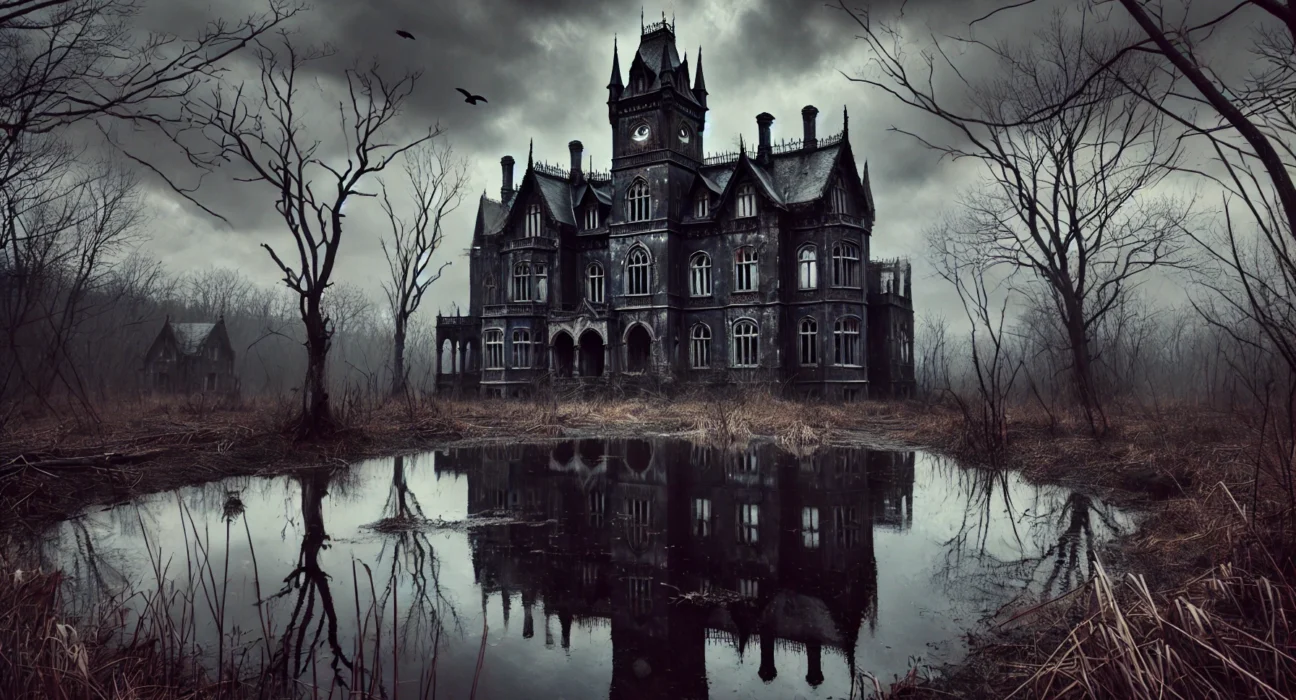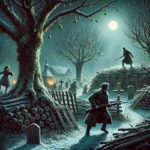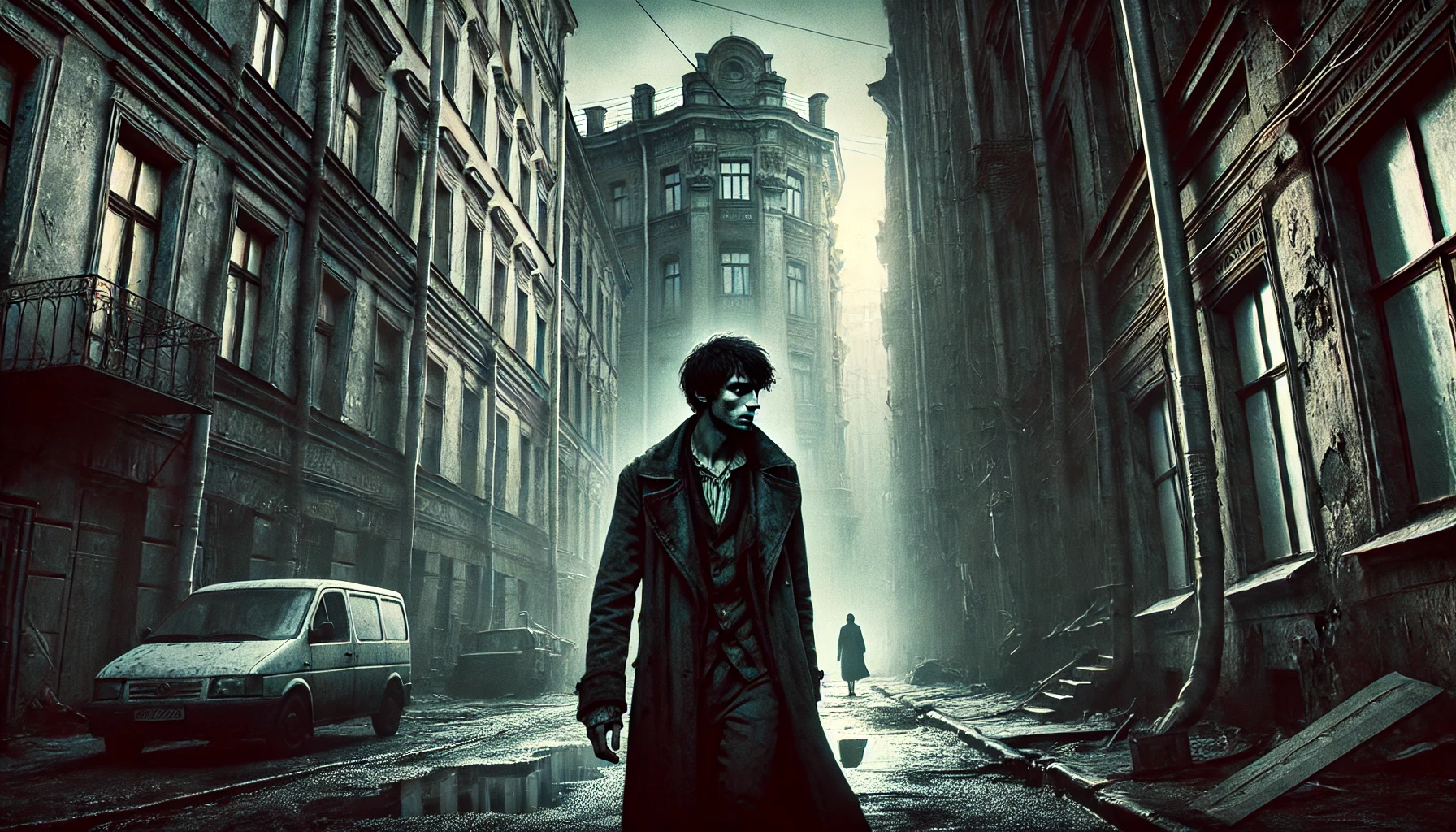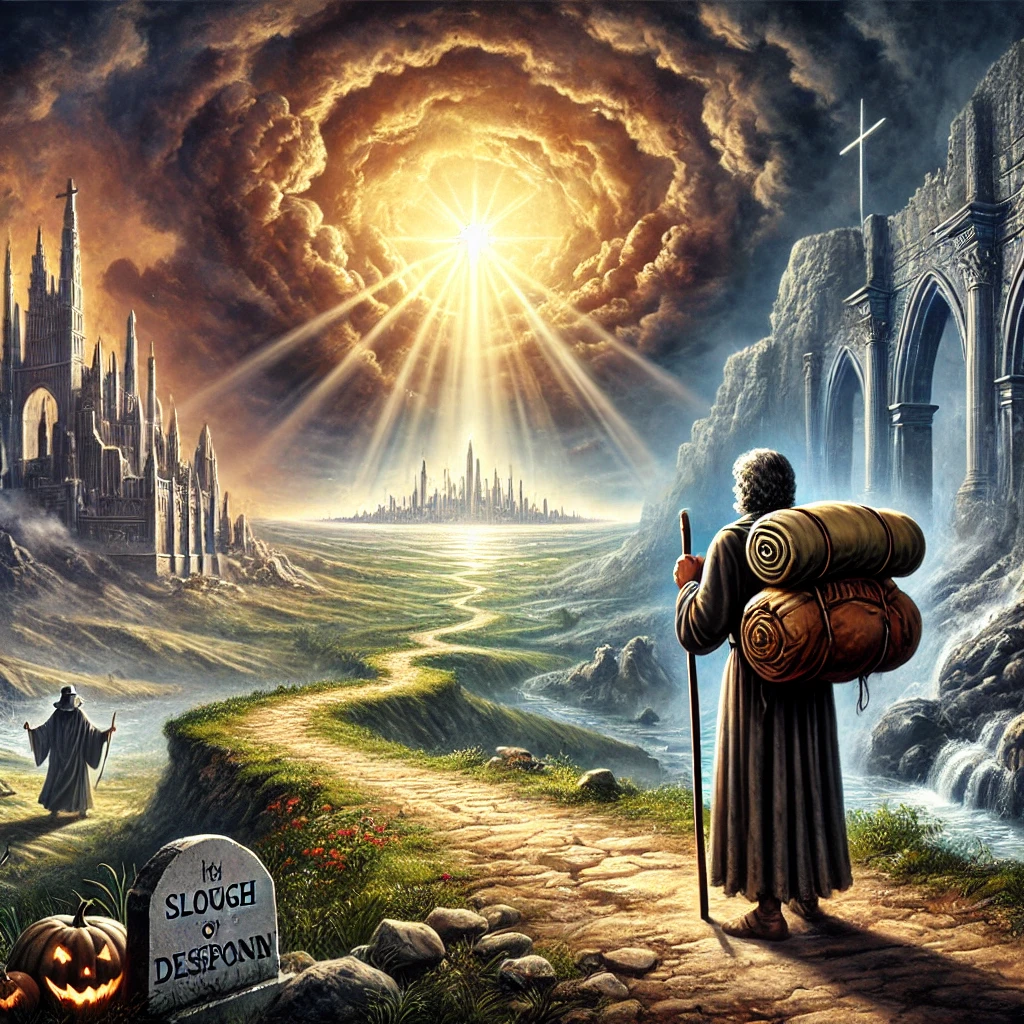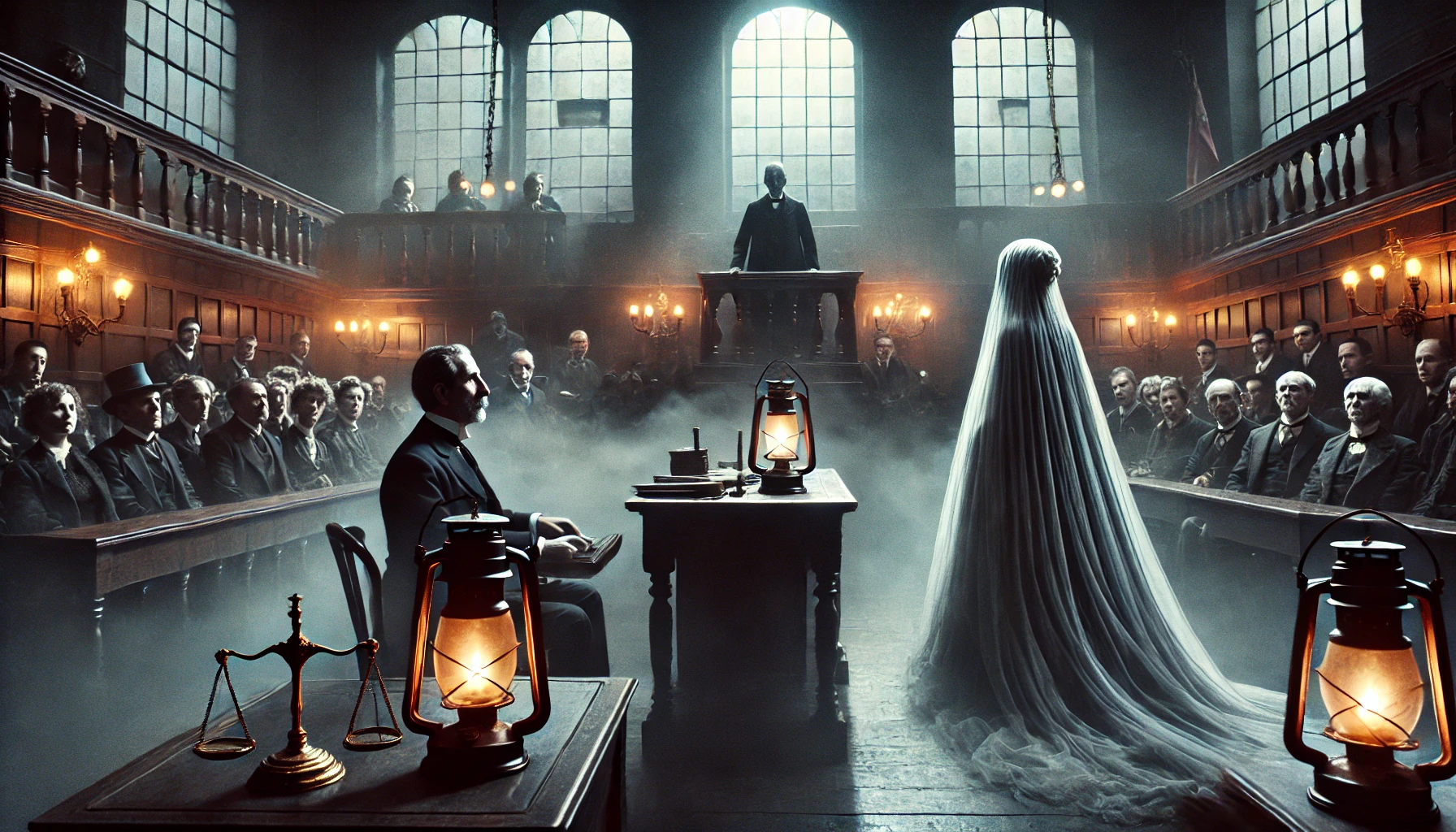“The Fall of the House of Usher” by Edgar Allan Poe, first published in 1839, is a quintessential piece of Gothic fiction. It delves into themes of madness, family decay, and the supernatural. Poe’s narrative is steeped in a chilling atmosphere that immerses readers in the eerie and melancholic world of the Usher family, embodied by the decaying mansion and its last inhabitants, Roderick and Madeline Usher.
Plot Summary
On a dark and dreary autumn day, the narrator approaches the House of Usher, a mansion of gothic grandeur oppressed by an insufferable gloom. Invited by his childhood friend Roderick Usher, the narrator is struck by a sense of foreboding as he gazes upon the bleak walls, vacant windows, and decayed trees surrounding the tarn. The mansion itself seems to exude an atmosphere of decay and despair, as if the very stones are imbued with a malignant sentience.
Roderick Usher, afflicted by a mysterious illness, has summoned the narrator to help alleviate his suffering. The Usher family, known for its peculiar temperament and artistic prowess, is now reduced to Roderick and his twin sister, Madeline. The siblings share an almost supernatural bond, and Roderick is deeply affected by Madeline’s progressive, debilitating illness. The narrator recalls their childhood friendship, noting Roderick’s excessive reserve and the family’s history of peculiar sensibility.
Upon arrival, the narrator is struck by Roderick’s ghastly appearance—cadaverous complexion, luminous eyes, and incoherent behavior. Usher explains his condition: an acute sensitivity of the senses and a profound fear of impending doom. He believes the mansion exerts a sinister influence over him, enhancing his madness and despair. The narrator learns of the Usher family’s unique traits and their uninterrupted lineage, which has perhaps led to a merging of the house’s identity with that of its inhabitants.
Madeline’s condition worsens, and she succumbs to a death-like trance. Roderick, fearing she may be prematurely buried, decides to entomb her temporarily in the family vault. The narrator assists in the burial, noting the striking resemblance between the twins and the faint blush on Madeline’s face, suggesting she might still be alive. The vault, damp and oppressive, lies beneath the narrator’s sleeping chamber, adding to the eerie ambiance.
In the following days, Roderick’s condition deteriorates further. He roams the mansion aimlessly, exhibiting increasing signs of madness. The narrator, too, begins to feel the oppressive atmosphere, experiencing strange and inexplicable sensations. The pervasive gloom seems to emanate from the house itself, wrapping the inhabitants in its suffocating embrace. The narrator attempts to alleviate Roderick’s melancholy through painting, reading, and listening to his improvised dirges, but all efforts are in vain.
One stormy night, unable to sleep, the narrator hears strange sounds and is visited by a hysterical Roderick. To calm him, the narrator reads from a gothic romance, the “Mad Trist” of Sir Launcelot Canning. As the narrator reads, the sounds described in the tale eerily manifest within the mansion—the cracking of wood, the shriek of a dragon, and the clanging of a shield. These coincidences unsettle the narrator, who struggles to maintain his composure.
Roderick, in a state of heightened terror, reveals that he has heard his sister’s movements in the coffin for days but was too paralyzed by fear to act. The narrator is horrified by this revelation, his mind racing with the implications of Madeline being entombed alive. As if on cue, the doors burst open, revealing Madeline, bloodied and in her death throes. She falls upon her brother, and in their final struggle, they both perish, their lives extinguished by the very fears that had haunted them.
Terrified, the narrator flees the mansion. As he crosses the old causeway, he turns to see a blood-red moon shining through a widening fissure in the house. With a final, tumultuous roar, the House of Usher collapses into the tarn, swallowed by the dark waters, leaving no trace of its cursed legacy. The once grand mansion, a symbol of the Usher family’s decay and madness, is now no more, its oppressive presence eradicated from the earth.
The narrator’s mind reels from the horrors he has witnessed. The oppressive atmosphere, the intertwining fates of Roderick and Madeline, and the ultimate destruction of the House of Usher leave an indelible mark on his soul. As he looks back at the tarn, now calm and unremarkable, he reflects on the tragic end of his friend and the eerie events that led to the demise of the Usher lineage.
In the end, the House of Usher, with its centuries of accumulated gloom and sorrow, succumbs to its own weight, both physical and metaphysical. The narrator’s escape marks the end of an era of madness and decay, as the oppressive legacy of the Usher family is finally laid to rest beneath the dark waters of the tarn. The tale of the House of Usher, with its haunting images and profound melancholy, lingers in the mind, a testament to the power of fear and the inevitable decline of those who are consumed by it.
Main Characters
Roderick Usher: The last male heir of the Usher family, Roderick is a childhood friend of the narrator. He is a deeply troubled individual, suffering from acute sensory sensitivity and a profound sense of dread. His mental state deteriorates further following his sister’s death.
Madeline Usher: Roderick’s twin sister, Madeline is afflicted with a mysterious illness that leaves her in a death-like cataleptic state. Her premature burial and subsequent return from the grave drive the story to its climax.
The Narrator: An unnamed childhood friend of Roderick Usher, the narrator provides a rational perspective to the eerie events. He becomes increasingly affected by the house’s oppressive atmosphere and the unfolding horrors.
Theme
Madness: Both Roderick and the narrator experience psychological torment, which is exacerbated by the house’s eerie atmosphere. The thin line between sanity and insanity is a central theme.
Family Decay and Isolation: The Ushers’ lineage is marked by physical and mental decline. The isolation of Roderick and Madeline, coupled with their intense familial bond, underscores their tragic fate.
Supernatural and Gothic Elements: The story is rich with Gothic motifs—an ancient, decaying mansion, a gloomy landscape, mysterious illnesses, and a palpable sense of doom. These elements create an atmosphere of horror and suspense.
The Power of Fear: Fear permeates the narrative, influencing the characters’ actions and ultimately leading to their demise. Roderick’s dread of the future and his superstitious belief in the house’s malevolent influence are pivotal.
Writing Style and Tone
Edgar Allan Poe’s writing style in “The Fall of the House of Usher” is characterized by its elaborate descriptions, rich symbolism, and a pervasive tone of melancholy and dread. Poe’s linguistic choices—using ornate and often archaic language—enhance the Gothic atmosphere. His narrative technique, which includes detailed psychological descriptions and a focus on sensory experiences, immerses the reader in the characters’ tormented minds.
The tone of the story is one of inevitable doom, underscored by the oppressive and decaying setting. Poe’s meticulous attention to detail creates a vivid, almost tangible atmosphere of horror. The use of first-person narration adds a layer of immediacy and intimacy, drawing readers deeper into the eerie and unsettling world of the House of Usher. Through his masterful use of language and tone, Poe crafts a story that lingers in the reader’s mind long after the final collapse of the house into the tarn.
We hope this summary has sparked your interest and would appreciate you following Celsius 233 on social media:
There’s a treasure trove of other fascinating book summaries waiting for you. Check out our collection of stories that inspire, thrill, and provoke thought, just like this one by checking out the Book Shelf or the Library
Remember, while our summaries capture the essence, they can never replace the full experience of reading the book. If this summary intrigued you, consider diving into the complete story – buy the book and immerse yourself in the author’s original work.
If you want to request a book summary, click here.
When Saurabh is not working/watching football/reading books/traveling, you can reach him via Twitter/X, LinkedIn, or Threads
Restart reading!


